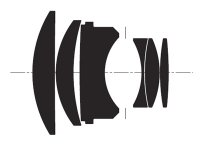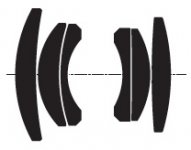Keith
The best camera is one that still works!
I recently bought a nearly new 50mm Planar f1.4 for my 'Evil' Nikon and after using it a little I'm curious about the formula of this lens. I've noticed when it encounters a strong light source near the edge of the frame in an otherwise fairly dark composition at wide apertures, it will flare occasionally and cast a bit of a ghost in towards the centre of the image from the light source.
I realised I'd seen this before but couldn't quite remember where and then the penny dropped ... the 80mm Planar T* on my Hasselblad does exactly the same thing.
I wouldn't have a clue what type of flare this is technically but I don't mind it I must admit. Is this a characteristic of the Planar design and if so how many lenses of various focal lengths, SLR and rangefinder, are there out there with this optical formula? I might add I've never seen this type of thing on any other lens I own!
this was shot @ f2.8 with the 80mm Planar (Hasselblad) with a strong sidelight coming in from the left of the image from a very bright window

with the 50mm @ f4 Planar (Nikon) and strong sidelight from an open door just out of frame to the right

I realised I'd seen this before but couldn't quite remember where and then the penny dropped ... the 80mm Planar T* on my Hasselblad does exactly the same thing.
I wouldn't have a clue what type of flare this is technically but I don't mind it I must admit. Is this a characteristic of the Planar design and if so how many lenses of various focal lengths, SLR and rangefinder, are there out there with this optical formula? I might add I've never seen this type of thing on any other lens I own!
this was shot @ f2.8 with the 80mm Planar (Hasselblad) with a strong sidelight coming in from the left of the image from a very bright window

with the 50mm @ f4 Planar (Nikon) and strong sidelight from an open door just out of frame to the right

photony texas
Light Sensitive
keitH, I wish I could help you with this but I am not a technical guru like a lot of the RFF-ers on the site. The lens design is 114 -115 years old and has a lot of air-to-glass surfaces which tends to promote flare. I guess coatings help, maybe a lens expert could shed some "light" on this. I wouldn't worry your photos are always "Bad-Ass" (American Slang for GREAT) what the heck is a little light glow anyway... 
Chriscrawfordphoto
Real Men Shoot Film.
There are several Planar formulas that have been made over the years. The version used in the Rolleiflex TLRs didn't have as many elements as the version made for the Hasselblad and Rollei 6x6 SLRs. The Planar sold for Leica-M today is nothing like the Planars of the past; its a standard double-gauss design like the Leica Summicon and most 50mm lenses for 35mm cameras today.
Rob-F
Likes Leicas
The lens design is 114 -115 years old and has a lot of air-to-glass surfaces which tends to promote flare. I guess coatings help . . .
This is a very accurate insight concerning the Planar and its glass-to-air surfaces. When Dr. Rudolph at Zeiss designed it sometime before 1900, he simply put his design away in a filing cabinet, knowing it probably could not be built in his lifetime because of the excessive internal reflections. It was not until the invention of magnesium fluoride coatings several decades later that the Planar became practical.
Concerning the version for the Rollei, I read that the Planar at first had five elements. Then a sixth one was added, reportedly to improve field flatness. But (according to the author) no one could tell the difference in practical photography!
Freakscene
Obscure member
No such thing
No such thing
The Zeiss Planars aren't the same, let alone anyone else's. The Hasselblad 80 has seven elements in six groups:
http://www.zeiss.com/C12567A8003B8B...02211_e/$File/Planar2.8_80mm_CFE_102211_e.pdf
the ZF 50/1.4 has seven elements in five groups:
http://www.zeiss.com/C12571FF00438F...573D40055917C/$file/slr_flyer_p_1_4_50_en.pdf
The Rollei TLR Planars have five elements in four groups.
The original Zeiss patent was for a lens with six elements in six groups.
The word "Planar" really doesn't mean anything specific enough to say "all Planars flare like this".
Marty
No such thing
The Zeiss Planars aren't the same, let alone anyone else's. The Hasselblad 80 has seven elements in six groups:
http://www.zeiss.com/C12567A8003B8B...02211_e/$File/Planar2.8_80mm_CFE_102211_e.pdf
the ZF 50/1.4 has seven elements in five groups:
http://www.zeiss.com/C12571FF00438F...573D40055917C/$file/slr_flyer_p_1_4_50_en.pdf
The Rollei TLR Planars have five elements in four groups.
The original Zeiss patent was for a lens with six elements in six groups.
The word "Planar" really doesn't mean anything specific enough to say "all Planars flare like this".
Marty
In modern times there's a "basic" Planar pattern exemplified by the 50/2 Planar-ZM (shown below at right). 6 elements in 4 groups arranged symmetrically: Plus, Plus-Minus cemented pair, diaphragm, Minus-Plus cemented pair, Plus. For SLR use this apparently needs to be modified a bit for the increased back-focus distance, by separating and reshaping the 2nd and third elements. An example of this is the old Pentax-M 50mm f/1.7. Going to 50mm f/1.4 requires a seventh element, a plus added at the rear, examples from both Pentax and Zeiss, and widely used by other makers as well, a popular starting point.
The seven-element five-group 80mm Planar for Hasselblad has its seventh element slid in between the first element and the first cemented pair, rather than added at the rear, an interesting variant.
First shown below is the six-element SLR-type Zeiss 85 f/1.4 Planar-ZK, whose pattern looks very like the 50mm f/1.7 from Pentax; imagine an added Plus element at rear for a Zeiss or Pentax 50/1.4 and also for the Voigtlander 58/1.4 SLII. At right is the standard RF-type Planar pattern exemplified by the 50/2 Planar-ZM.
The seven-element five-group 80mm Planar for Hasselblad has its seventh element slid in between the first element and the first cemented pair, rather than added at the rear, an interesting variant.
First shown below is the six-element SLR-type Zeiss 85 f/1.4 Planar-ZK, whose pattern looks very like the 50mm f/1.7 from Pentax; imagine an added Plus element at rear for a Zeiss or Pentax 50/1.4 and also for the Voigtlander 58/1.4 SLII. At right is the standard RF-type Planar pattern exemplified by the 50/2 Planar-ZM.
Attachments
Last edited:
Tim Gray
Well-known
I thought the Planar design was just Zeiss's name for the double Gauss design. I'm sure it's changed a bit over the course of it's history. Not all double Gauss designs are the same, tweaked with different glasses or elements. I also think that even if anan extra element here or there is snuck in, it's still considered a double Gauss design, since it the design started off with a symmetrical 6 element layout.
Share:


